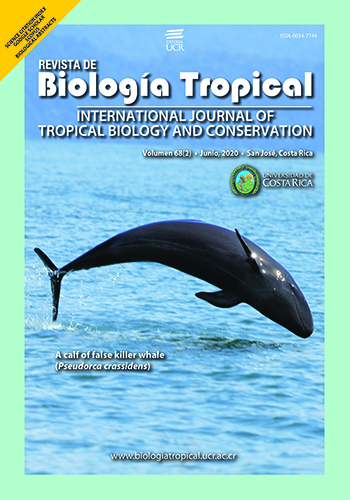Resumen
Introducción: La falsa orca es una especie gregaria tropical y subtropical, que vive en grupos con individuos de diferentes clases de edad y sexo. La falsa orca ha sido documentada en el sur-oeste de Costa Rica desde finales de los 90s. Objetivo: Evaluar el uso de hábitat de la especie en términos de abundancia. Métodos: Observaciones en campo para cetáceos en aguas de la Península de Osa (APO), incluyen encuentros oportunísimos en Bahía de Drake y la Isla del Caño (2001-2015), así como observaciones directas de Pseudorca crassidens, durante muestreos formales en Golfo Dulce (2005-2015). Se analizaron datos sobre foto-identificación utilizando modelos de marcaje captura y recaptura, considerando un enfoque para población abierta (POPAN), el cual considera el efecto del tiempo en los parámetros demográficos: supervivencia aparente (ф) y probabilidad de captura (P), produciendo un estimado de abundancia que comprende toda la superpoblación en el área de estudio. Resultados: La abundancia de la falsa orca en APO se caracteriza por un tamaño poblacional pequeño, de menos de 100 individuos, que se complementa por una muy baja probabilidad de captura, en contraste con una supervivencia aparente alta. Conclusión: Este estimado debe tratarse como conservativo, no obstante, el pequeño número poblacional, de menos de 100 individuos debe considerarse como vulnerable, en contraste con el incremento del impacto antropogénico del paisaje marino costero. Se discute la posible presencia de unidades poblacionales en el paisaje costero del litoral Pacífico y de unidades oceánicas asociadas a la Isla del Coco.
##plugins.facebook.comentarios##

Esta obra está bajo una licencia internacional Creative Commons Atribución 4.0.
Derechos de autor 2020 Erika Sánchez Robledo, Lenin Enrique Oviedo Correa, Dr., David Herra-Miranda, Juan Diego Pacheco-Polanco, MSc, Sierra Goodman, Hector Guzman, Dr.


